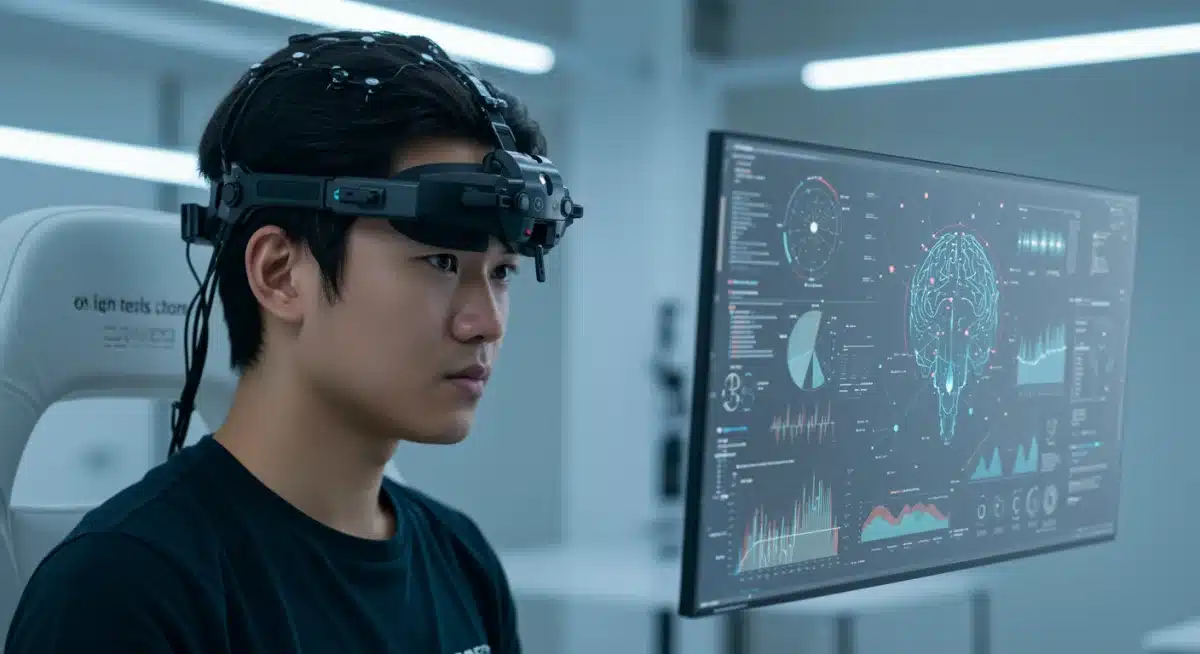Future Human-Computer Interaction: 3 Breakthroughs Expected

The Future of Human-Computer Interaction is poised for transformative advancements, with three key breakthroughs – neural interfaces, enhanced haptic feedback, and AI-driven adaptive systems – anticipated to redefine how humans interact with technology within the next year.
The landscape of how we interact with technology is on the brink of a revolution. As of today, the Future of Human-Computer Interaction is accelerating, with experts projecting three monumental breakthroughs within the next 12 months that promise to fundamentally reshape our digital and physical realities.
Recent developments indicate a rapid acceleration in research and development, setting the stage for these innovations to move from laboratories to practical applications. The implications for industries ranging from healthcare to entertainment are profound, signaling a new era of seamless, intuitive, and highly personalized technological engagement.
Neural Interfaces: Direct Brain-to-Device Communication
The most groundbreaking development expected in the coming year is the advancement of neural interfaces, enabling direct communication between the human brain and digital devices. This technology, once confined to science fiction, is rapidly approaching mainstream viability, promising unprecedented levels of control and interaction.
Leading research institutions and tech giants are reporting significant progress in reducing the invasiveness and increasing the accuracy of these interfaces. Early prototypes are demonstrating the ability to control external devices with thought alone, bypassing traditional input methods like keyboards or touchscreens.
Non-Invasive BCI Advancements
Breakthroughs in non-invasive Brain-Computer Interface (BCI) technologies are particularly noteworthy. These systems, which do not require surgical implantation, are becoming more sophisticated and accessible. Researchers are leveraging advanced signal processing and machine learning to interpret brain activity with greater precision.
- Enhanced Signal Processing: New algorithms are filtering out noise and isolating specific neural commands more effectively.
- Miniaturization: Devices are becoming smaller and more discreet, resembling everyday wearables.
- Increased Accuracy: The ability to accurately translate thoughts into actions is rapidly improving.
Medical and Accessibility Applications
The immediate impact of these advancements is expected to be most profound in medical and accessibility fields. Patients with severe motor impairments could regain significant autonomy, controlling prosthetics, wheelchairs, and communication devices directly with their minds.
Neural interfaces offer a pathway to enhanced quality of life for millions. The ethical considerations surrounding brain data privacy and security are being addressed concurrently, as these technologies move towards broader public release, according to statements from leading research consortiums.


Hyper-Realistic Haptic Feedback Systems
Another major breakthrough anticipated is the evolution of haptic feedback systems, moving beyond simple vibrations to deliver hyper-realistic sensations. This advancement will allow users to ‘feel’ digital objects, textures, and even environmental conditions with unprecedented fidelity, blurring the lines between the digital and physical worlds.
Companies specializing in virtual and augmented reality are at the forefront of this innovation, integrating advanced haptic gloves and suits into their ecosystems. The goal is to create immersive experiences where users can perceive the weight, temperature, and texture of virtual elements as if they were tangible.
Advanced Actuator Technologies
The core of this breakthrough lies in new actuator technologies capable of generating a wider range of tactile sensations. Unlike traditional vibration motors, these new devices can simulate pressure, friction, and even shear forces, providing a much richer sensory experience.
- Microfluidic Systems: Tiny channels filled with fluid can change shape and pressure to mimic textures.
- Electroactive Polymers: Materials that deform in response to electrical fields are creating dynamic haptic feedback.
- Ultrasonic Transducers: Focused sound waves are being used to create localized sensations on the skin without direct contact.
Applications Across Industries
The implications of hyper-realistic haptic feedback extend far beyond gaming and entertainment. In surgical training, medical students could practice procedures on virtual patients with realistic tactile feedback. In design and engineering, professionals could ‘feel’ prototypes before physical construction, accelerating development cycles. Retail experiences could also be transformed, allowing customers to virtually touch fabrics or product finishes before purchase.
AI-Powered Adaptive User Interfaces
The third significant breakthrough involves the widespread adoption of AI-powered adaptive user interfaces (AUIs) that intuitively learn and adjust to individual user needs, preferences, and even emotional states. These interfaces will move beyond static designs to dynamically reconfigure themselves, offering a truly personalized interaction experience.
Current UI/UX design paradigms are often one-size-fits-all, but the next generation of interfaces will leverage artificial intelligence to observe user behavior, predict intentions, and proactively optimize the interaction flow. This means interfaces that anticipate your next click, suggest relevant information before you search, and even adapt their visual presentation based on your cognitive load.
Contextual Awareness and Personalization
Key to these AUIs is their ability to understand context. Using a combination of sensor data (location, time of day, device usage), biometric inputs (heart rate, gaze tracking), and historical interaction patterns, AI systems will build a comprehensive model of each user. This model then informs how the interface presents information and options.
- Predictive Input: Interfaces will anticipate user commands, making interactions faster and more efficient.
- Emotional Intelligence: AI could detect frustration or engagement and adjust the interface’s complexity or responsiveness.
- Dynamic Layouts: UI elements will rearrange themselves based on current tasks and user focus, minimizing distractions.
Enhanced Efficiency and Accessibility
The immediate benefit of AI-powered adaptive interfaces will be a dramatic increase in efficiency and a reduction in cognitive load. Users will spend less time navigating menus and more time accomplishing tasks. Furthermore, these interfaces hold immense potential for accessibility, automatically adapting to the specific needs of users with disabilities, such as adjusting font sizes, color contrasts, or input methods without explicit configuration.
As reported by leading AI research labs, the integration of advanced machine learning models is making these adaptive systems not just possible, but highly effective, promising a future where technology truly understands and serves its human counterparts.
Ethical Considerations in HCI Evolution
As these revolutionary advancements in the Future of Human-Computer Interaction emerge, critical ethical considerations are coming to the forefront. The development and deployment of neural interfaces, hyper-realistic haptic systems, and AI-powered adaptive UIs raise questions about privacy, consent, data security, and potential societal impacts. Tech companies and regulatory bodies are actively engaging in discussions to establish guidelines that ensure responsible innovation.
The collection of neural data, for instance, necessitates robust security protocols and clear user consent mechanisms. Similarly, the potential for manipulation through highly personalized, adaptive interfaces requires careful ethical frameworks to prevent misuse. Transparency in how AI systems learn and adapt is also crucial for building user trust and ensuring equitable access to these powerful new technologies.
Data Privacy and Security
With brain activity, biometric data, and detailed interaction patterns being collected, the stakes for data privacy and security have never been higher. Developers are focusing on end-to-end encryption and decentralized data storage solutions to protect sensitive user information. Regulations similar to GDPR are being considered globally to address these new categories of personal data.
- Anonymization Techniques: Advanced methods to de-identify data are crucial for research and development.
- User Control: Giving users granular control over what data is collected and how it’s used is paramount.
- Threat Mitigation: Continuous development of cybersecurity measures to protect against new forms of attack targeting neural and biometric data.
Inclusivity and Digital Divide
Ensuring that these advanced HCI technologies are accessible to all, and do not exacerbate existing digital divides, is another key ethical challenge. The cost and complexity of initial implementations could create barriers. Efforts are underway to develop more affordable and user-friendly versions, alongside initiatives to educate the public and provide training on these new interaction paradigms.
International collaborations are also exploring frameworks to ensure global equity in access to these transformative technologies, preventing a future where only a select few benefit from the most advanced forms of human-computer interaction.
The Economic and Social Impact
The impending breakthroughs in the Future of Human-Computer Interaction are poised to generate significant economic and social ripple effects across the globe. Industries will be reshaped, new job roles will emerge, and the very fabric of daily life will experience profound transformations. From manufacturing to education, the way humans interact with machines will become more intuitive and integrated, leading to increased productivity and novel forms of engagement.
Early economic forecasts suggest a boom in sectors directly tied to these technologies, such as advanced sensor manufacturing, AI development, and specialized software engineering. Furthermore, the social implications include changes in how we learn, work, and communicate, potentially fostering new forms of community and collaboration, while also presenting challenges related to digital literacy and adaptation.
New Industries and Job Creation
The rise of neural interfaces, advanced haptics, and adaptive UIs will undoubtedly spur the creation of entirely new industries. Companies focused on BCI hardware, haptic content creation, and AI-driven UI customization will thrive. This will, in turn, generate a demand for specialized skills, creating new job opportunities in areas such as neuro-engineering, haptic design, and AI ethics.
- Neuro-Engineer: Specializing in the design and implementation of brain-computer interfaces.
- Haptic Experience Designer: Crafting tactile sensations for virtual and augmented realities.
- AI Interaction Strategist: Focusing on how AI optimizes and personalizes user experiences.
Societal Transformation
Beyond the economic sphere, these advancements will influence societal norms and expectations. Education could become more immersive and personalized through adaptive learning environments. Healthcare could see more effective remote diagnostics and rehabilitation with haptic feedback. Even social interactions could evolve, with new forms of digital communication offering richer sensory experiences. As these technologies become more pervasive, understanding their long-term social impact will be crucial for policymakers and communities alike.
Challenges and Future Outlook
While the prospects for the Future of Human-Computer Interaction are incredibly promising, significant challenges remain on the path to widespread adoption. Technical hurdles, such as improving the reliability and bandwidth of neural signals, reducing latency in haptic systems, and ensuring the robustness of AI adaptive algorithms, are actively being addressed by researchers worldwide. Furthermore, issues of cost, standardization, and public acceptance must be overcome for these technologies to truly integrate into everyday life.
The next 12 months will be critical in demonstrating the practical viability and scalability of these breakthroughs. Initial deployments will likely focus on niche applications in medical, industrial, and high-end entertainment sectors, gradually expanding to broader consumer markets as the technologies mature and become more affordable. The pace of innovation suggests a dynamic and rapidly evolving landscape, with continuous improvements and new applications emerging regularly.
Overcoming Technical Hurdles
Researchers are intensely focused on refining the core technologies. For neural interfaces, this includes developing more stable and long-lasting non-invasive sensors. For haptic feedback, the challenge is creating devices that are both powerful enough to simulate diverse sensations and compact enough for practical use. AI adaptive systems require continuous data streams and sophisticated learning models to maintain their relevance and effectiveness over time.
- Signal-to-Noise Ratio: Improving the clarity of neural signals for more accurate interpretation.
- Energy Efficiency: Developing low-power components for wearables and portable devices.
- Algorithmic Bias: Ensuring AI systems are fair and unbiased in their adaptations across diverse user groups.
Public Acceptance and Integration
Beyond technical prowess, the success of these new HCI paradigms hinges on public acceptance. Addressing concerns about privacy, security, and the perceived ‘naturalness’ of interaction will be key. User education and intuitive design will play a crucial role in making these advanced technologies feel like a seamless extension of human capabilities rather than complex, alien tools. Early positive experiences will be vital in building trust and fostering widespread adoption.
| Key Breakthrough | Brief Description |
|---|---|
| Neural Interfaces | Enabling direct brain-to-device communication, enhancing control and accessibility. |
| Hyper-Realistic Haptics | Delivering advanced tactile sensations to blur digital and physical realities. |
| AI Adaptive UIs | Interfaces that learn and adjust intuitively to individual user needs and preferences. |
Frequently Asked Questions About Future HCI
Neural interfaces allow direct communication between the brain and devices. In daily life, this means controlling computers or smart home devices with thoughts, enhancing accessibility for individuals with disabilities, and potentially transforming gaming and professional tasks by eliminating physical input barriers.
Haptic feedback will evolve beyond simple vibrations through microfluidic systems, electroactive polymers, and ultrasonic transducers. These technologies will simulate detailed sensations like texture, pressure, temperature, and even friction, creating far more immersive and tangible virtual experiences across various applications.
An AI-powered adaptive user interface (AUI) is a system that uses artificial intelligence to learn user preferences, behaviors, and emotional states. It then dynamically adjusts its layout, content, and functionality to provide a highly personalized and efficient interaction experience, anticipating user needs and optimizing engagement.
Key ethical concerns include data privacy and security, especially with neural and biometric data. There are also questions about user consent, the potential for digital divide, and the responsible use of AI in shaping user experiences to prevent manipulation or bias. Establishing robust regulatory frameworks is paramount.
Healthcare and accessibility will see immediate benefits from neural interfaces. Gaming, entertainment, and training simulations will be transformed by hyper-realistic haptics. Across all sectors, including education, manufacturing, and general consumer technology, AI-powered adaptive interfaces will enhance efficiency and personalization, creating widespread impact.
What Happens Next
The rapid evolution in the Future of Human-Computer Interaction signifies a pivotal shift in how humanity engages with technology. As these three breakthroughs—neural interfaces, hyper-realistic haptics, and AI-powered adaptive systems—move from advanced research to commercial viability, the coming months will reveal their initial real-world impacts. We anticipate a surge in pilot programs across medical, industrial, and entertainment sectors, setting precedents for broader adoption. Regulatory bodies globally are also expected to accelerate discussions on data privacy and ethical guidelines, shaping the responsible deployment of these transformative tools. Keep an eye on announcements from major tech conferences and research consortiums for the latest developments.





